Fiber & Mebeverine Combination Calculator
Your Recommended Combination
Soluble Fiber
Take 4.0g daily with at least 250ml water.
Ideal for IBS-D patients to reduce cramping and stool consistency.
If you suffer from IBS, you’ve probably heard of Mebeverine. But how does it work alongside the fiber you eat every day? This guide breaks down the science, the practical tips, and the common mistakes so you can calm those cramps and get back to enjoying meals.
How Mebeverine relaxes the smooth muscle of the gastrointestinal tract, reducing spasms and abdominal pain works
Mebeverine belongs to the antispasmodic class of drugs. It binds to receptors on the gut’s smooth‑muscle cells and blocks calcium influx, which prevents the muscle from contracting too hard. The result is fewer cramps, less urgency, and a calmer colon. Because it works locally in the gut and isn’t absorbed much into the bloodstream, systemic side effects are rare.
Typical dosing in the UK is 135mg three times a day, taken before meals to coincide with the peak of digestive activity. The drug reaches its maximum effect within 30-60minutes, which is why timing matters when you pair it with food‑based strategies such as fiber.
The role of fiber dietary carbohydrate that resists digestion in the small intestine and provides bulk or gel in the colon in IBS
Fiber is a staple of most IBS dietary recommendations, but not all fiber is created equal. Broadly, fiber falls into two categories:
- Soluble fiber dissolves in water to form a gel‑like substance, slowing digestion and helping regulate stool consistency
- Insoluble fiber adds bulk to stool and speeds up transit through the colon
In IBS‑D (diarrhea‑predominant), soluble fiber such as psyllium (Plantago ovata) is usually better tolerated because it can firm up loose stools without causing gas. In IBS‑C (constipation‑predominant), a mix of soluble and a modest amount of insoluble fiber (e.g., wheat bran) can help stimulate movement without over‑inflating the gut.
Besides stool bulk, fiber feeds the gut microbiome, promoting short‑chain fatty acids that reduce inflammation and improve motility. The key is consistency - sudden spikes in fiber can trigger bloating, especially when combined with a spasm‑prone colon.
Combining Mebeverine with fiber: what the evidence says
Clinical trials from the early 2000s to recent meta‑analyses have explored the combo. The main take‑aways are:
- Patients on Mebeverine who added a low‑dose soluble fiber (2-4g of psyllium per day) reported a 30% greater reduction in abdominal pain scores than those on Mebeverine alone.
- Combining high‑dose insoluble fiber with Mebeverine often increased flatulence and did not improve stool frequency, suggesting a ceiling effect for muscle‑relaxant benefits.
- Timing matters - taking Mebeverine 30minutes before a fiber‑rich meal maximises the drug’s ability to smooth muscle contraction while the fiber forms a gel that slows transit.
In short, the sweet spot is a modest amount of soluble fiber taken with or just after Mebeverine, especially for IBS‑D patients.
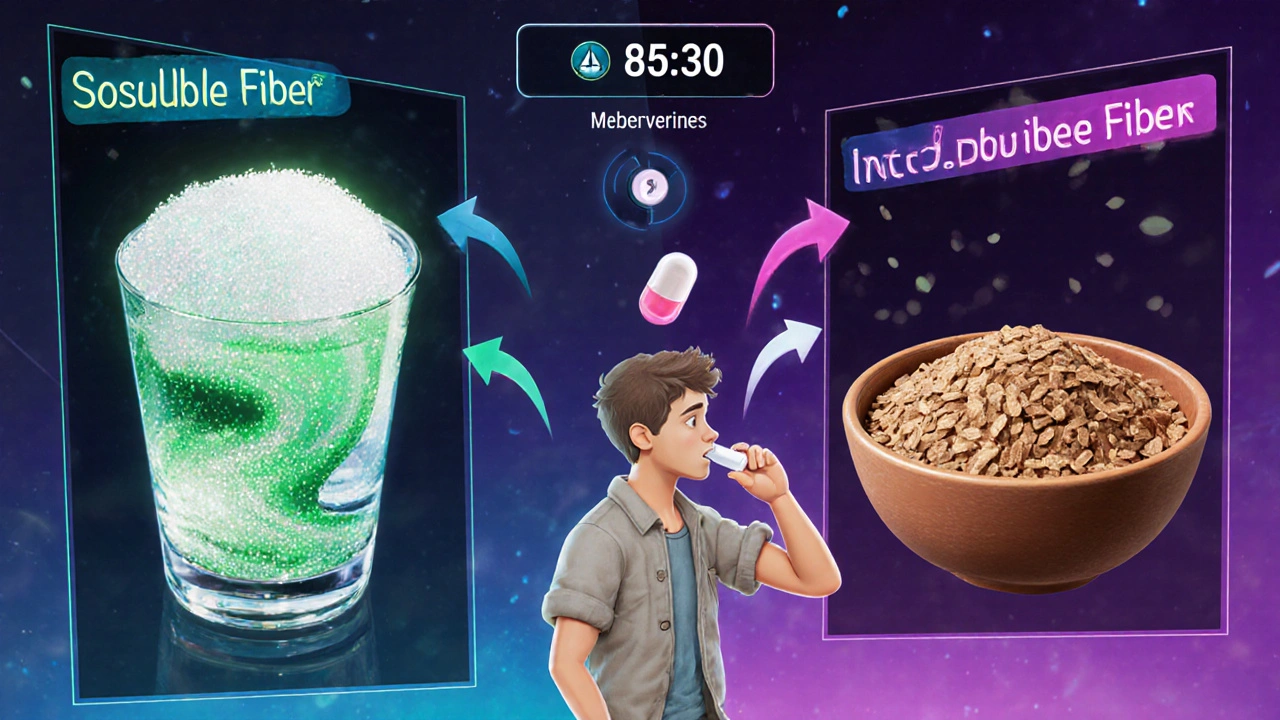
Practical guide: choosing the right fiber type
| Feature | Soluble Fiber | Insoluble Fiber |
|---|---|---|
| Typical Sources | Psyllium, oats, barley, apples | Whole wheat, wheat bran, nuts, seeds |
| Effect on Stool | Forms gel, softens hard stool, can firm loose stool | Adds bulk, speeds up transit |
| Bloating Risk | Low to moderate (if introduced gradually) | Higher, especially in large doses |
| Best for IBS‑D | ✓ | ✗ |
| Best for IBS‑C | ✓ (with moderate dose) | ✓ (small amount) |
| Interaction with Mebeverine | Synergistic - smooths muscle and gels contents | Potentially antagonistic - rapid bulk may trigger spasms |
Start with 1g of psyllium mixed in water or yoghurt, then increase by 1g every 3‑4 days until you reach 4-6g daily, depending on tolerance. If you need extra bulk, sprinkle a teaspoon of wheat bran into a smoothie - but keep it under 5g total to avoid flare‑ups.
Dosage, timing, and safety tips for the combo
- Take Mebeverine 30minutes before meals. This gives the drug time to relax the gut walls before the fiber starts swelling.
- Consume the fiber with at least 250ml of water. Soluble fiber expands, and insufficient fluid can cause obstruction.
- Monitor your Bristol Stool Chart. Aim for a type 3-4 (smooth, sausage‑shaped) as a sign that the balance is right.
- Watch for side effects: Though rare, Mebeverine can cause dry mouth or dizziness. If you notice these, talk to your GP about dose adjustment.
- Never exceed 10g of psyllium per day without medical advice - high doses can interfere with the absorption of other meds.
For pregnant or breastfeeding patients, both Mebeverine and modest fiber are considered safe, but always confirm with a healthcare professional.
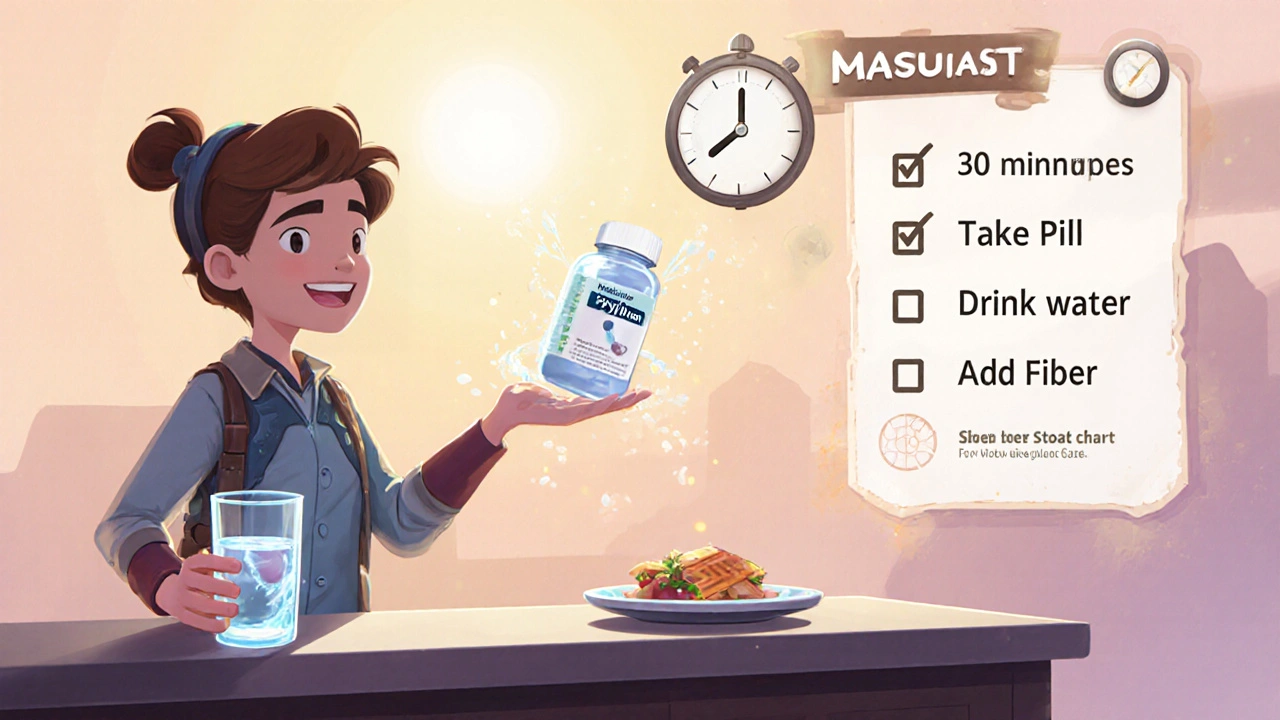
Common pitfalls and how to avoid them
Pitfall 1: Loading up on fiber all at once. The gut’s bacteria need time to adapt. Increase slowly and keep a symptom diary.
Pitfall 2: Skipping the water. Fiber without enough fluid can create a plug in the colon, leading to constipation or, paradoxically, more cramps.
Pitfall 3: Ignoring the type of IBS. Using a lot of insoluble fiber in IBS‑D can worsen diarrhea, while too little bulk in IBS‑C may leave you stuck.
Pitfall 4: Taking Mebeverine with antacids. Some antacids raise stomach pH and can slow the drug’s onset. Separate them by at least two hours.
Frequently Asked Questions
Can I take Mebeverine and a probiotic together?
Yes. Probiotics act on the microbiome, while Mebeverine targets muscle spasms. Taking them together can improve overall IBS control, but start the probiotic at a low dose to watch for extra gas.
Is psyllium safe for people with diverticulosis?
Current guidelines suggest soluble fiber like psyllium is actually beneficial for diverticular disease because it softens stool and reduces pressure. However, stay within the recommended 3-6g daily and keep hydrated.
What should I do if I miss a dose of Mebeverine?
Take the missed tablet as soon as you remember, unless it’s almost time for your next dose. In that case, skip the missed one - don’t double‑dose.
Can fiber interfere with the effectiveness of Mebeverine?
When taken correctly (Mebeverine before the meal and fiber with plenty of water), there’s no negative interaction. In fact, soluble fiber can enhance the smooth‑muscle‑relaxing effect by providing a more predictable stool bulk.
How long will it take to notice improvement?
Most patients report reduced cramping within 3‑5 days of consistent Mebeverine use. Adding fiber may extend that timeline by a week as your gut adjusts, but the combined effect usually becomes evident by week two.
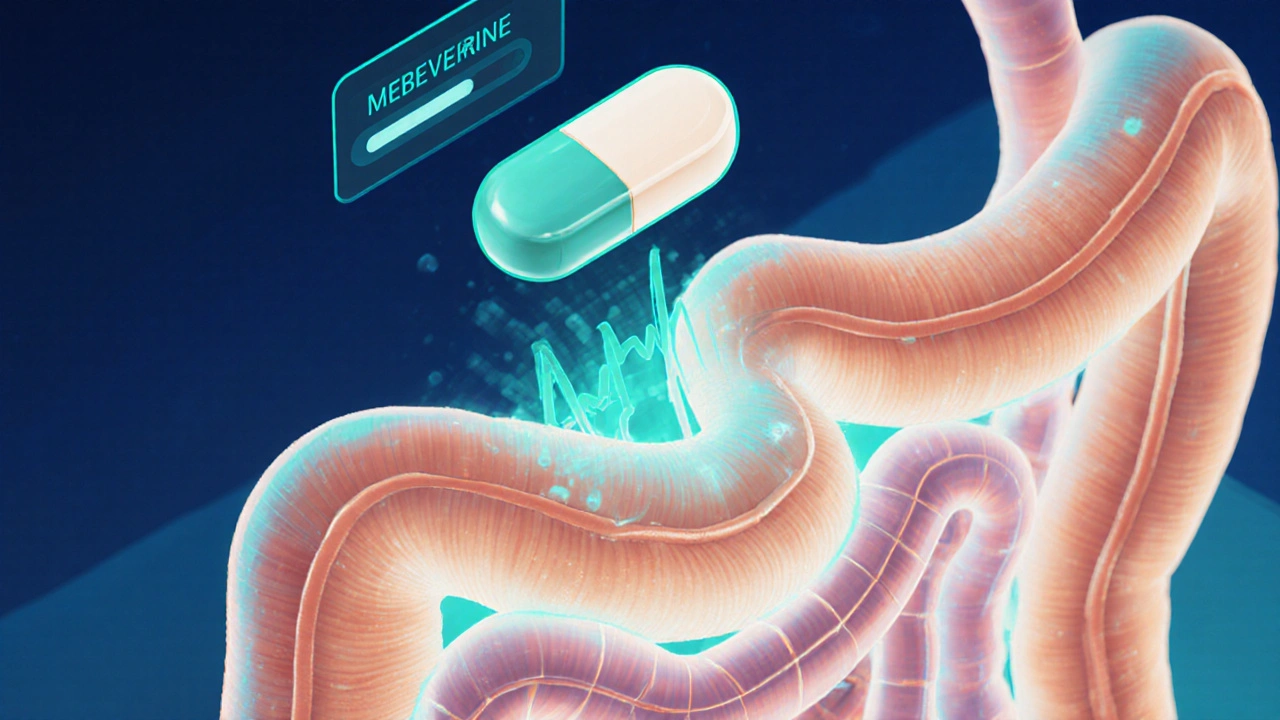
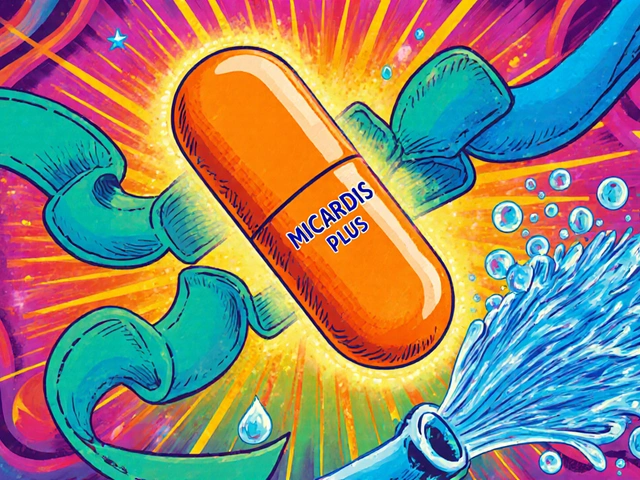

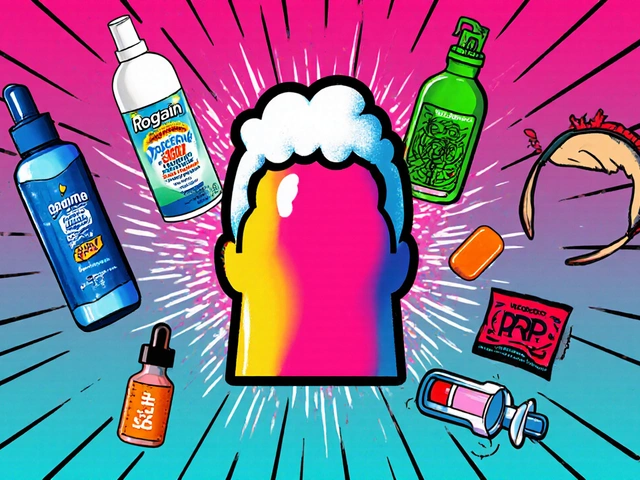
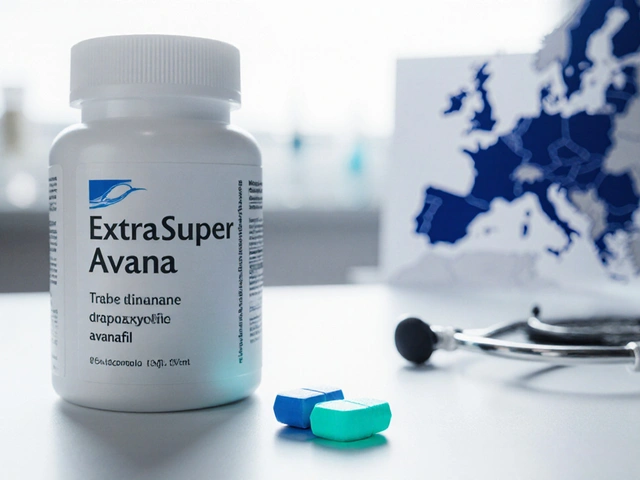
Keelan Walker
October 15, 2025 AT 18:01Hey everyone, glad to see this discussion about IBS management 😊 Mebeverine is a handy tool when it comes to calming those unpredictable gut cramps It works by relaxing the smooth muscle without flooding your bloodstream with heavy meds Because it stays mostly in the gut you usually won’t feel the usual anticholinergic side effects Timing is key – taking it half an hour before you eat gives it a chance to settle the colon When you pair it with the right kind of fiber you can create a double‑boost effect Soluble fiber like psyllium forms a gel that slows down transit and makes the muscle less likely to spasm Insoluble fiber, on the other hand, can be a bit rough on a sensitive gut if you overdo it Start with a small dose of psyllium mixed in plenty of water and watch how your body reacts Increase the amount gradually by a gram every few days until you hit the sweet spot Keep your water intake up because fiber expands and needs fluid to move smoothly If you notice any dry mouth or mild dizziness, check with your doctor – it’s usually nothing serious For IBS‑D patients, the combo of low‑dose psyllium and Mebeverine often cuts pain scores by about a third For IBS‑C you might need a touch of insoluble fiber but stay below five grams total Remember to monitor your stool type on the Bristol chart and aim for a smooth, sausage‑shaped number three or four Consistency is the secret sauce – sudden spikes in fiber can undo all the good work you’ve done 😊
Heather Wilkinson
October 16, 2025 AT 21:48Thanks for the thorough rundown! 😊 Your step‑by‑step approach makes it easy to try without feeling overwhelmed. I love how you highlighted the water point – staying hydrated really does the trick. It’s nice to see the encouragement to adjust slowly rather than jump in. Keep spreading the good vibes!
Henry Kim
October 18, 2025 AT 01:35Appreciate the clear guidance. I’ve found that taking Mebeverine before breakfast and a teaspoon of psyllium works for me. Listening to my body’s signals helped me avoid the bloating spikes. Thanks for sharing.
Neha Bharti
October 19, 2025 AT 05:21Pairing soluble fiber with Mebeverine maximizes relief while keeping gas low – start low and build slowly.
Samantha Patrick
October 20, 2025 AT 09:08Exactly! Just remember to drink at least 250ml of water with the psyllium or you might get a constipation plug – i.e. dont skipp the water.
Christopher Pichler
October 21, 2025 AT 12:55From a pharmacodynamic standpoint, the synergistic modulation of gut motility via antispasmodic agents and gel‑forming soluble fiber represents a classic example of multimodal therapy – if you enjoy layering mechanisms like a tech stack you’ll love this combo. Of course, the data isn’t groundbreaking, but it’s useful for those who like to justify every supplement with a meta‑analysis.
VARUN ELATTUVALAPPIL
October 22, 2025 AT 16:41Wow!!! This is sooo interesting!!! Are you sure about the dosage???!!!
April Conley
October 23, 2025 AT 20:28Take the fiber with plenty of water.
Sophie Rabey
October 25, 2025 AT 00:15Oh sure, because we all remember to drink eight glasses before a fiber binge 😂.
Bruce Heintz
October 26, 2025 AT 03:01Great summary! I’ve been mixing a scoop of psyllium with my morning yoghurt and it’s been a game‑changer 😄.
richard king
October 27, 2025 AT 06:48In the theater of the gut, Mebeverine takes the quiet, stoic role of the peacekeeper. It slides onto the stage of the colon, coaxing the muscles to bow out of their spasmodic frenzy. Yet without the humble hero of soluble fiber, its performance would be a muted whisper. Psyllium, the unassuming gel, gathers the audience of chyme into a cohesive troupe. Together they choreograph a ballet of peristalsis that is both graceful and restrained. When the timing aligns – half an hour before the feast – the duet sings in harmony. If you rush the curtain with a sudden surge of insoluble bulk, the drama turns tragic. Bloating erupts like an over‑zealous applause that drowns the quiet applause of comfort. Thus the lesson is simple: respect the pacing, honor the water, and cherish consistency. Do not tempt fate by loading your plate with a mountain of bran on an empty stomach. Observe the Bristol chart as a script, aiming for the middle act, not the extremes. Patience, dear reader, is the understudy that eventually steps into the limelight. Every gram of psyllium added slowly is a line delivered with confidence. When the curtain falls after weeks of diligent practice, relief takes its bow. And so the gut finds its peace, a silent chorus that hums beneath the daily grind.
Dalton Hackett
October 28, 2025 AT 10:35Proper hydration and fiber intake are cornerstones of gastrointestinal health. The interplay between antispasmodics like Mebeverine and soluble fiber is a fascinating physiologic synergy. When you introduce psyllium gradually, you allow the microbiome to adapt without triggering excess gas. It is crucial to measure your fiber dose with a kitchen scale for accuracy. Drinking at least 250 milliliters of water per gram of psyllium prevents the formation of a viscous plug. Some patients report minor dry mouth, which usually resolves with a sip of water. If you experience dizziness, consider discussing dosage adjustments with your physician. Remember that the Bristol Stool Chart is a valuable visual tool for monitoring progress. Consistency, not intensity, leads to sustainable improvement. And never forget to check for potential drug‑fiber interactions, especially with thyroid medications – a detail many overlook. This regimen, when followed correctly, can definately improve quality of life; just be patient and keep notes.
William Lawrence
October 29, 2025 AT 14:21Sure, but the evidence isn’t as clear‑cut as you make it sound.
Grace Shaw
October 30, 2025 AT 18:08Esteemed community members, I wish to address the protocol surrounding the concomitant administration of Mebeverine and dietary fiber with the utmost decorum. The pharmacological rationale for deploying an antispasmodic agent to attenuate colonic hypercontractility is well established in peer‑reviewed literature. Nevertheless, the incorporation of soluble fiber demands a judicious approach, lest one precipitate iatrogenic bloating. It is incumbent upon clinicians to counsel patients regarding the necessity of adequate aqueous intake concomitant with fiber supplementation. Moreover, the temporal separation of Mebevrine ingestion and the subsequent ingestion of a fiber‑rich meal, approximately thirty minutes as elucidated in clinical trials, optimizes therapeutic synergy. One must also remain vigilant for rare adverse events, such as xerostomia, and advise appropriate mitigation strategies. In practice, the titration of psyllium from one gram to a maximum of six grams over a fortnight has yielded favorable outcomes in numerous case series. The integration of the Bristol Stool Form Scale facilitates objective assessment and should be incorporated into routine monitoring. Ultimately, the convergence of pharmacotherapy and nutritional modulation offers a comprehensive avenue for ameliorating IBS symptomatology. I trust this exposition proves beneficial to both practitioners and patients alike.
Sean Powell
October 31, 2025 AT 21:55Totally vibes with the formal guide – just add a dash of mango chutney for fun and keep the water flowing lol